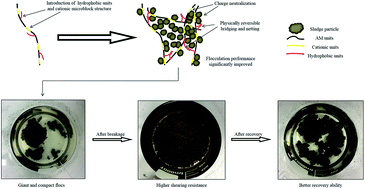Waste activated sludge (WAS) dewatering properties of an original hydrophobically modified polyacrylamide containing a cationic microblock structure†
Abstract
Chemical conditioning, as one of the core technologies used for the dewatering pretreatment of sludge, can efficiently improve the dewaterability of WAS and hence reduce the expense of the transportation and disposal of WAS. Cationic polyacrylamide has been widely utilized as a chemical conditioner owing to its high performance and economic advantages. However, high-performance and economical flocculants are still needed. In this study, a novel hydrophobically associating polyacrylamide, which was denoted as TPADL and contained a cationic microblock structure synthesized by a UV-initiated template copolymerization technique, was employed in a dewatering test on WAS. The chemical composition of TPADL was confirmed via hydrogen nuclear magnetic resonance (1H NMR) spectroscopy and Fourier transform infrared (FTIR) spectroscopy. Moreover, 1H NMR spectroscopy demonstrated a highly concentrated distribution of cations on the main chain. Furthermore, thermogravimetric analysis (TGA) was utilized to investigate the thermal stability of TPADL, and its apparent viscosity was also measured to evaluate its rheological characteristics. Dewatering tests found that the TPADL flocculant exerted a synergistic function owing to the cationic microblock structure and hydrophobic association and exhibited superior dewatering performance in comparison with normal random cationic polyacrylamide (CPAM). The filter cake moisture content (FCMC) and specific resistance to filtration (SRF) reached 64.98% and 1.3 × 1012 m kg−1, respectively, for TPADL at the optimal dosage of 1.5 mg g−1 dry solids of WAS (calculated value). The floc size distribution revealed that hydrophobic association remarkably increased the floc size owing to enhancements in bridging absorption ability, whereas the cationic microblock structure helped form a denser and more compact floc structure, and the higher charge neutralization ability enabled an increase in floc strength. In addition, the synergistic function significantly improved the regeneration ability of flocs. Scanning electron microscopy (SEM) analysis indicated that the stronger floc structure could act as a skeleton to form pores and a channel-like structure, which made filter cake a favorable draining medium for the release of water and thus contributed to an increase in dewaterability. This study provided an analysis for the development of high-performance and economic flocculants by a combination of the controllable concentrated distribution of cations and hydrophobic association.



 Please wait while we load your content...
Please wait while we load your content...